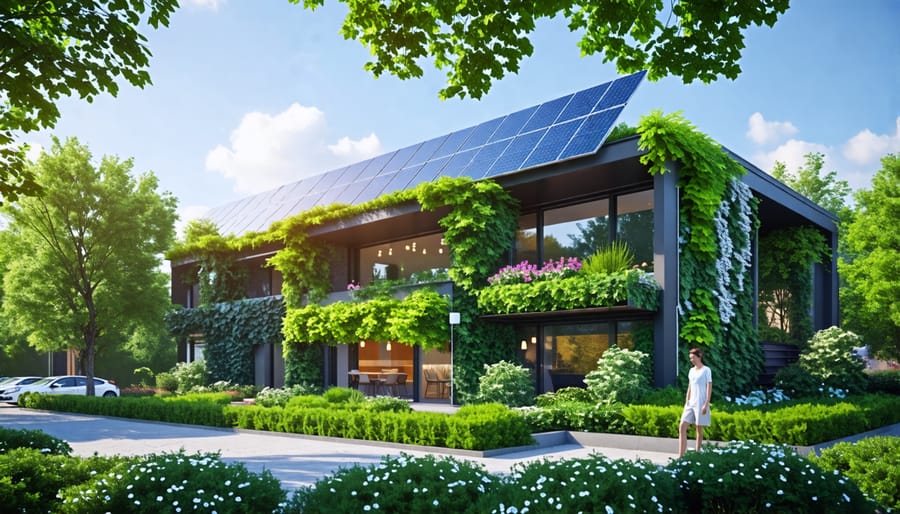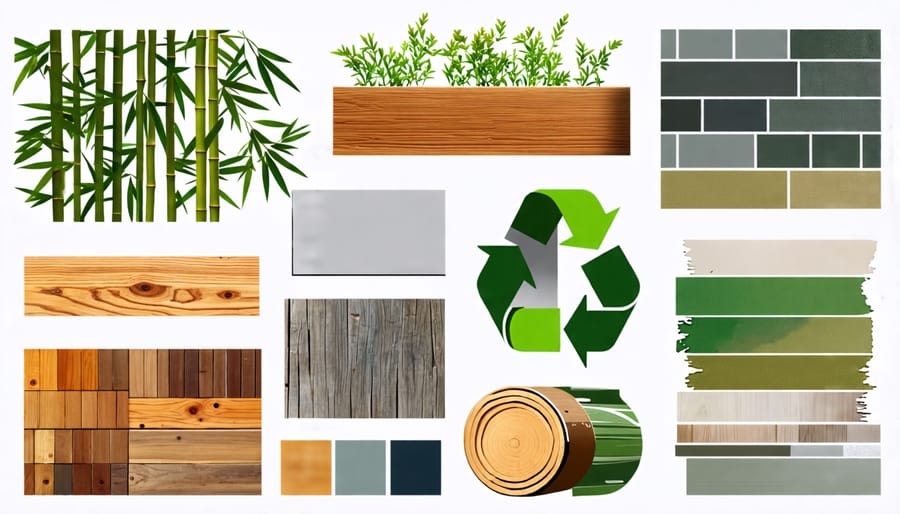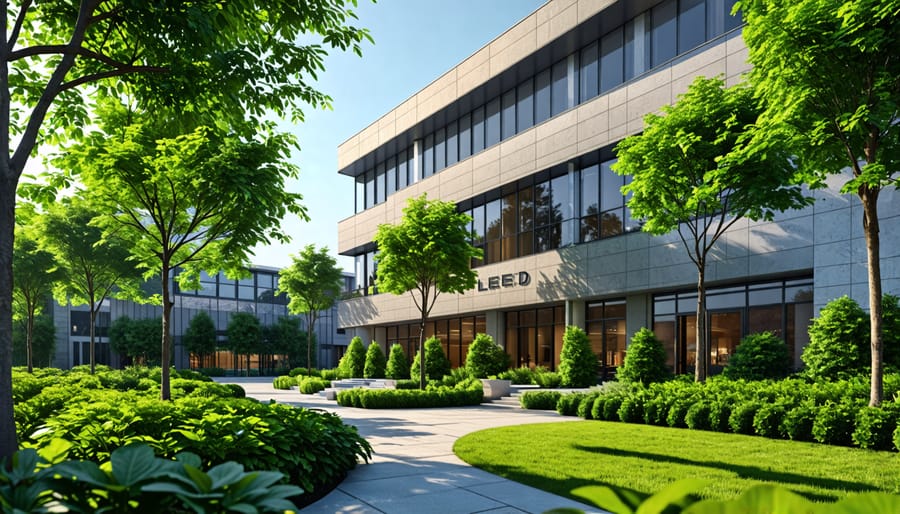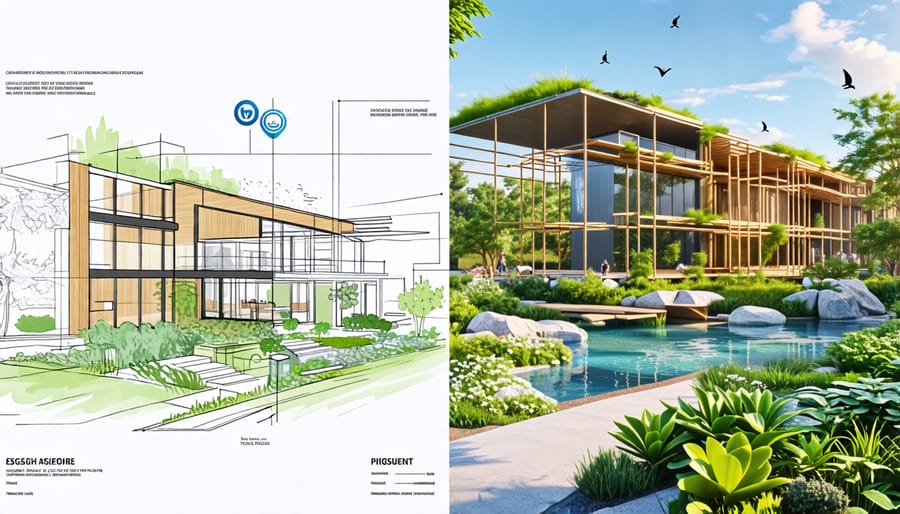Embrace sustainable construction principles to minimize environmental impact and maximize resource efficiency. Integrate green building materials, such as recycled steel, bamboo, and low-VOC paints, to reduce the carbon footprint of your projects. Implement energy-efficient technologies, including solar panels, geothermal systems, and smart HVAC controls, to optimize operational sustainability. Achieve recognized certifications, such as LEED or BREEAM, to demonstrate your commitment to sustainable practices and gain a competitive edge in the market.
Key Principles of Sustainable Construction

Minimizing Environmental Impact
Minimizing the environmental impact of construction projects is a core pillar of sustainable construction. One key strategy is to carefully select building materials that have a lower carbon footprint, such as recycled steel, bamboo, or sustainably sourced timber. Efficient waste management practices, including recycling and repurposing construction debris, can significantly reduce the ecological footprint of a project.
Implementing energy-efficient technologies, such as solar panels, geothermal systems, and smart building management systems, can dramatically decrease a building’s long-term energy consumption. Water conservation measures, like rainwater harvesting, greywater recycling, and low-flow plumbing fixtures, help to minimize the strain on local water resources.
Sustainable site planning, which preserves natural habitats, minimizes soil disturbance, and incorporates green spaces, is another crucial aspect of reducing the environmental impact of construction. By employing these strategies, the construction industry can play a vital role in creating a more sustainable built environment.
Resource Efficiency
Resource efficiency is a critical aspect of sustainable construction, focusing on optimizing the use of materials, water, and energy throughout a building’s lifecycle. This approach involves careful selection of materials, prioritizing those that are renewable, recycled, or locally sourced to minimize environmental impact and transportation emissions. Efficient water management strategies, such as rainwater harvesting, greywater recycling, and low-flow fixtures, help conserve this precious resource. Energy efficiency is achieved through passive design techniques, like natural ventilation and daylighting, as well as active strategies, such as high-performance insulation, energy-efficient appliances, and renewable energy systems. By conducting life cycle assessments and employing lean construction methods, project teams can identify opportunities to reduce waste, optimize resource use, and minimize the overall environmental footprint of the construction process. Embracing resource efficiency not only benefits the environment but also leads to long-term cost savings and improved building performance.
Enhancing Indoor Environmental Quality
Sustainable construction prioritizes indoor environmental quality to promote occupant health, comfort, and well-being. This involves designing buildings with optimal air quality, thermal comfort, acoustic performance, and access to natural light. Strategies include using low-emitting materials, implementing effective ventilation systems, and incorporating biophilic design elements. By carefully selecting materials and designing spaces that minimize indoor pollutants, regulate temperature and humidity, and reduce noise pollution, sustainable buildings create healthier and more productive environments for their occupants. Ultimately, enhancing indoor environmental quality not only benefits the people who use the building but also contributes to the overall sustainability of the built environment.
Sustainable Building Materials and Technologies

Green Building Materials
Green building materials are essential components of sustainable construction practices. Low-impact options include bamboo, a rapidly renewable resource with excellent strength and durability properties. Recycled steel, which can contain up to 100% recycled content, significantly reduces the environmental impact of construction projects. Insulated concrete forms (ICFs) provide superior thermal performance and are made from recycled materials like polystyrene and cement.
Renewable materials such as cork, linoleum, and sheep’s wool offer sustainable alternatives for flooring and insulation. These materials are biodegradable, have low embodied energy, and contribute to improved indoor air quality. Reclaimed wood from deconstructed buildings or salvaged sources adds character while reducing the demand for virgin lumber.
Recycled plastics find new life in construction as decking, fencing, and roofing materials. These products divert waste from landfills and often require less maintenance than traditional materials. Other eco-friendly options include low-VOC (volatile organic compound) paints, adhesives, and sealants, which minimize harmful emissions and contribute to healthier indoor environments.
By incorporating these sustainable materials, construction professionals can significantly reduce the carbon footprint of their projects while promoting resource efficiency and occupant well-being. As the demand for green buildings continues to grow, adopting low-impact, renewable, and recycled materials will be crucial in driving the industry towards a more sustainable future.
Energy-Efficient Technologies
Energy-efficient technologies are transforming the construction industry, enabling buildings to drastically reduce operational energy consumption. Smart HVAC systems, powered by AI and IoT, continuously optimize heating and cooling based on occupancy and weather data. Advanced insulation materials, such as aerogel and vacuum-insulated panels, provide superior thermal performance while minimizing wall thickness. Energy-efficient technologies like LED lighting with intelligent controls and daylight harvesting further decrease electricity usage. Solar photovoltaic panels integrated into building facades and roofs generate clean, renewable energy on-site. Geothermal heat pumps leverage stable underground temperatures for efficient heating and cooling. High-performance windows with low-e coatings, triple glazing, and thermal breaks prevent heat loss and gain. These cutting-edge solutions, when combined with smart building management systems, create sustainable, comfortable, and cost-effective built environments that set new standards for energy efficiency in the construction industry.
Water Conservation Systems
Water conservation is a critical aspect of sustainable construction. Low-flow fixtures, such as toilets, showerheads, and faucets, can significantly reduce water consumption without compromising functionality. Rainwater harvesting systems collect and store rainwater for non-potable uses like irrigation and toilet flushing. Greywater recycling systems treat and reuse wastewater from sinks, showers, and washing machines for irrigation or toilet flushing. Drought-resistant landscaping, which incorporates native plants and efficient irrigation techniques, minimizes outdoor water usage. Smart irrigation controllers adjust watering schedules based on weather conditions and soil moisture levels. Leak detection systems promptly identify and address water leaks, preventing waste. By implementing these strategies and technologies, sustainable buildings can drastically reduce their water footprint, conserve precious resources, and lower utility costs. As water scarcity becomes an increasing concern, prioritizing water conservation in construction is not only environmentally responsible but also economically advantageous.
Sustainable Construction Certifications and Standards
LEED Certification
The Leadership in Energy and Environmental Design (LEED) rating system is a globally recognized framework for assessing and certifying the sustainability of buildings and construction projects. Developed by the U.S. Green Building Council (USGBC), LEED provides a comprehensive set of standards and criteria that evaluate a building’s environmental performance and impact. The rating system covers various aspects of sustainable construction, including site selection, water efficiency, energy performance, materials and resources, indoor environmental quality, and innovation in design.
LEED certification is awarded at four levels: Certified, Silver, Gold, and Platinum, based on the number of points earned across the different categories. To achieve certification, projects must meet a set of prerequisites and earn points by implementing sustainable strategies and technologies. The certification process involves rigorous documentation, third-party verification, and ongoing performance monitoring.
By pursuing LEED certification, construction professionals demonstrate their commitment to sustainability, reduce environmental impact, and create healthier, more efficient buildings. LEED-certified projects often benefit from lower operating costs, increased asset value, and improved occupant health and productivity. As the demand for sustainable construction grows, LEED certification has become an industry benchmark and a valuable marketing tool for building owners and developers.

BREEAM Certification
The Building Research Establishment Environmental Assessment Method, or BREEAM, is a widely recognized sustainability assessment method for masterplanning projects, infrastructure and buildings. Developed by BRE (Building Research Establishment) Global, BREEAM sets the standard for best practice in sustainable design and has become one of the most comprehensive and widely recognized measures of a building’s environmental performance.
BREEAM certification provides independent third-party validation of a project’s sustainability performance across a range of categories, including energy, land use, materials, waste, and water. Each category is sub-divided into a range of assessment issues, which have aims, targets and benchmarks that projects can be assessed against.
The assessment process evaluates the procurement, design, construction and operation of a development against targets that are based on performance benchmarks. Assessments are carried out by independent, licensed assessors, and developments rated and certified on a scale of Pass, Good, Very Good, Excellent and Outstanding.
BREEAM’s holistic approach to sustainability ensures that projects deliver tangible benefits for building owners, users, and the environment. By setting standards that surpass regulations, BREEAM challenges the construction industry to deliver innovative, cost-effective solutions that minimize the environmental impact of built structures. With its rigorous assessment criteria and commitment to driving sustainable best practices, BREEAM certification has become a mark of quality and achievement in the built environment.
Case Studies
Real-world case studies demonstrate the successful implementation of sustainable construction practices. One notable example is the Bullitt Center in Seattle, Washington, which achieved the rigorous Living Building Challenge certification. This six-story office building features a photovoltaic array that generates all of its electricity, a rainwater harvesting system for potable water, and composting toilets. The use of FSC-certified wood and low-emitting materials contributed to its sustainable design.
Another exemplary project is the Khoo Teck Puat Hospital in Singapore, which showcases biophilic design principles. The building incorporates extensive greenery, including a green roof, vertical gardens, and a waterfall feature. These elements not only reduce the urban heat island effect but also create a healing environment for patients. The hospital also utilizes natural ventilation and daylighting to minimize energy consumption.
The Stephanie Alexander Kitchen Garden at Majura Primary School in Canberra, Australia, is a smaller-scale project that demonstrates sustainable construction in an educational setting. The building uses recycled and locally sourced materials, such as reclaimed hardwood and stabilized rammed earth walls. It also features a green roof, rainwater harvesting, and passive solar design. This project shows that sustainable construction can be achieved at various scales and for different purposes.
These case studies highlight the diverse ways in which sustainable construction can be applied, from large-scale commercial buildings to smaller educational facilities. By incorporating renewable energy systems, water conservation measures, biophilic design, and low-impact materials, these projects set a high standard for the industry and inspire others to adopt sustainable practices in their own work.
Conclusion
Sustainable construction is a multifaceted approach that encompasses a wide range of strategies, materials, and technologies to minimize the environmental impact of buildings while creating healthier, more efficient spaces for people to live and work. By prioritizing energy efficiency, resource conservation, and waste reduction, sustainable construction practices offer numerous benefits, including lower operating costs, improved occupant health and productivity, and reduced greenhouse gas emissions. As the demand for green buildings continues to grow, driven by both environmental regulations and market demand, the adoption of sustainable construction practices is becoming increasingly critical for the industry’s future success.
Looking ahead, the future of sustainable construction is bright, with ongoing innovations in materials science, building technology, and design strategies promising to further advance the field. As more companies recognize the value of sustainability and integrate it into their core business strategies, the construction industry has a unique opportunity to lead the way in creating a more resilient, low-carbon future. By embracing sustainable construction practices and continuously pushing the boundaries of what is possible, the industry can not only contribute to a healthier planet but also unlock new opportunities for growth and innovation in the years to come.

